The government of India has been implementing device subsidies since the early 1990s, and the concept has since been modified and adapted based on the type of device.
It is advisable to shift to solar energy and give back to the environment by saving it as a homeowner in India. To make this transition easier to achieve the government offer subsidies to achieve the same task.
In this guide, you stand to learn how you can be able to secure such subsidies, equipment, costs as well as power supply capacity of these solar panels, and the general procedure that you have to follow in order to be able to access the program.
Solar Panel for Home Government Subsidy
The government of India provides a good amount of incentives to promote the utilization of solar power. This initiative falls under the Ministry of New and Renewable Energy, or MNRE for short. Here are the key points:
- Subsidy Amount: The subsidy ranges between 30% and 40% depending on the size of the system with systems of up to 3 kW eligible for the full amount. When the system is between 3 kW and 10 kW, it will be eligible for a subsidy of 20%.
- Eligibility: It is important to understand that the subsidy is available to only residential buildings. This does not apply to business, industrial, or any institution.
- Implementation: Subsidy is later provided through local DISCOMs (Distribution Companies).
Required Equipment for Solar Installation
To set up a solar power system at home, you need several key components:
- Solar Panels: Convert sunlight into electricity. Types include monocrystalline and polycrystalline panels.
- Inverter: Converts DC electricity from panels to AC electricity for home use.
- Mounting Structure: Supports the panels on your roof.
- Batteries: Optional, store excess energy for use during non-sunny hours.
- Cables and Wiring: Connect the system components.
- Junction Box: Ensures safe distribution of electricity.
- Monitoring System: Tracks the performance of your solar power system.
Costs and Charges
The cost of setting up a solar power system can vary. Here’s a breakdown of typical expenses:
- Solar Panels: ₹40,000 – ₹50,000 per kW
- Inverter: ₹10,000 – ₹20,000
- Mounting Structure: ₹5,000 – ₹10,000
- Other Components: ₹10,000 – ₹20,000
With subsidies, the effective cost reduces significantly. For example, a 3 kW system might cost around ₹1,20,000 before subsidy. After applying the 40% subsidy, the cost drops to ₹72,000.
Application Process
To avail of the subsidy, follow these steps:
- Contact Local DISCOM: Approach your local distribution company to express your interest in installing a solar power system.
- Submit Application: Fill out the application form provided by the DISCOM. You’ll need proof of residence, identity, and property ownership.
- Get Approval: The DISCOM will review your application and conduct a site visit.
- Install System: Once approved, hire an MNRE-approved vendor to install the system.
- Inspection and Commissioning: After installation, the DISCOM will inspect the system to ensure it meets required standards.
- Receive Subsidy: The subsidy amount is typically credited to your account or adjusted in your electricity bill.
Power Supply Capacity
There are various types of solar panel systems in the market with different sizes. Here’s a general idea of what different capacities can power:Here’s a general idea of what different capacities can power:
- 1 kW System: Most suitable for households that are small or which do not spend much on electricity. Is able to power 3-4 fans, 6-8 lights, 1 television, and 1 refrigerator.
Benefits of Solar Power
Switching to solar power offers numerous benefits:
- Cost Savings: Reduce your electricity bills significantly.
- Environmental Impact: Lower your carbon footprint.
- Energy Independence: Become less dependent on the grid.
- Increased Property Value: Homes with solar panels often have higher market values.
Conclusion
People living in India should consider installing solar panel at home as it is wise to do so. It is more accessible for anyone since it is supported by the government and can take up to 40% of the spending.
Thus, if you complete the application procedures and select the proper equipment, you can obtain clean and renewable energy. Reach out to your local DISCOM and find out what subsidies are applicable to you to begin your journey towards a more sustainable tomorrow.
Please, check online at the official website of MNRE or your local DISCOM for more information or updates.
Read also: 500W Solar Panel Price in India with Subsidy



